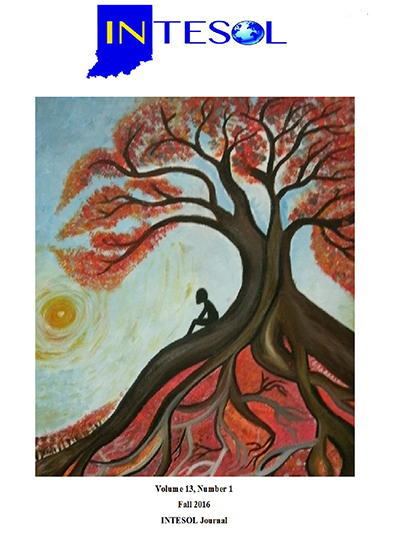Teacher and Student Perspectives on the Effectiveness of First-Year Composition in Preparing L2 Students for Discipline-Specific Writing
Abstract
The study described in this article was conducted to gather teachers’ and students’ perspectives about the effectiveness of a first-year composition course in preparing students for discipline-specific writing in college. Data were collected in a large research U.S. university through a student survey (n=32) and teacher interviews (n=5). The results show that the majority of the students and all instructors found the course effective and its assignments helpful in preparing students for writing in their university classes. In addition, all participated instructors also tried to improve the course by employing a variety of approaches and strategies, such as implementing assignments and skills generalizable across the disciplines, emphasizing the connection between general and discipline-specific writing, and encouraging students to do research on topics relevant to their fields of study. The article concludes with the recommendations on how to increase the effectiveness of first-year composition to better prepare students for their academic literacy experiences at the university.
References
Anderson, N., Evans, N., & Hartshorn, J. (2014). Reading and writing expectations of matriculated university students. Paper presented at the TESOL International Convention & English Language Expo, Portland, OR.
Belcher, D. (1995). Writing critically across the curriculum. In D. Belcher & G. Braine (Eds.), Academic writing in a second language: Essays on research and pedagogy, pp. 135-154. Norwood, NJ: Ablex.
Berkenkotter, C., Huckin, T., & Ackerman, J. (1991). Social context and socially constructed texts: The initiation of a graduate student into a writing research community. In C. Bazerman & J. Paradis (Eds.), Textual dynamics of the professions, pp. 191-215. Madison, WI: University of Wisconsin Press.
Braine, G. (1989). Writing in science and technology: An analysis of assignments from ten undergraduate courses. English for Specific Purposes, 8, 3-16.
Braine, G. (1995). Writing in the natural sciences and engineering. In D. Belcher & G. Braine (Eds.), Academic writing in a second language, pp. 113–134. Norwood, NJ: Ablex Publishing Corporation.
Carson, J. (2001). A task analysis of reading and writing in academic contexts. In D. Belcher & A. Hirvela (Eds.), Linking literacies: Perspectives on L2 reading–writing connections, pp. 48–83. Ann Arbor, MI: The University of Michigan Press.
Currie, P. (1999). Transferable skills: Promoting student research. English for Specific Purposes, 18(4), 329-345.
DePalma, M. J., & Ringer, J. M. (2011). Toward a theory of adaptive transfer: Expanding disciplinary discussions of “transfer” in second-language writing and composition studies. Journal of Second Language Writing, 20(2), 134-147.
Expected Outcomes. (n. d.). Purdue University core curriculum. Retrieved from http://www.purdue.edu/provost/initiatives/curriculum/outcomes.html
Hale, G., Taylor, C., Bridgeman, B., Carson, J., Kroll, B., & Kantor, R. (1996). A study of writing tasks assigned in academic degree programs. Princeton, NJ: Educational Testing Service.
Horowitz, D. M. (1986). What professors actually require: Academic tasks for the ESL classroom. TESOL Quarterly, 20(3), 445-462.
ICaP Advisor Guide 2015-2016. Retrieved from: http://icap.rhetorike.org/sites/default/files/AdvisorGuide2015-16_0.pdf
ISS Enrollment and Statistical Report, Fall 2015 (2015). International Students and Scholars. Retrieved from https://www.iss.purdue.edu/resources/Docs/Reports/ISS_StatisticalReportFall15.pdf.
James, M. A. (2006a). Teaching for transfer in ELT. ELT Journal, 60(2), 151-159.
James, M. A. (2006b). Transfer of learning from a university content-based EAP course. TESOL Quarterly, 40, 783-806.
James, M. A. (2009). “Far” transfer of learning outcomes from an ESL writing course: Can the gap be bridged? Journal of Second Language Writing, 18(2), 69-84.
Johns, A. (1988). Another reader reacts . . .. TESOL Quarterly, 22, 705-707.
Johns, A. (1991). Faculty assessment of ESL student literacy skills: Implications for writing assessment. In L. Hamp-Lyons (Ed.), Assessing second language writing in academic contexts, pp. 167–179. Norwood, NJ: Ablex Publishing Corporation.
Leki, I. (1995). Coping strategies of ESL students in writing tasks across the curriculum. TESOL Quarterly, 29, 235-260.
Leki, I., & Carson, J. G. (1997). Completely different worlds: EAP and the writing experiences of ESL students in university courses. TESOL Quarterly, 31, 39-69.
Ostler, S. E. (1980). A survey of academic needs for advanced ESL. TESOL Quarterly, 14, 489-502.
Purdue University Office of Provost. (n. d.). Purdue University core curriculum. Retrieved from http://www.purdue.edu/provost/initiatives/curriculum/index.html
Snow, M. A. (1993). Discipline-based foreign language teaching: Implications from ESL/EFL. In M. Krueger & F. Ryan (Eds.), Language and content: Discipline- and content-based approaches to language study, pp. 37-56. Lexington, MA: D.C. Heath and Co.
Spack, R. (1988). Initiating ESL students into the academic discourse community: How far should we go? TESOL Quarterly, 22, 29-51.
Spack, R. (1997). The acquisition of academic literacy in a second language: A longitudinal case study. Written Communication, 14(1), 3–62.
WPA Outcomes Statement for First-Year Composition. (2014). Council of Writing Program Administrators. Retrieved from http://wpacouncil.org/positions/outcomes.html.
University Senate Educational Policy Committee. (2012). Undergraduate outcome-based curriculum and administration & oversight structure. Retrieved from http://www.purdue.edu/provost/initiatives/curriculum/documents/Senate%20Document%2011-7%20Final%20Appendices%20and%20Rubrics.pdf
Zhu, W. (2004a). Faculty views on the importance of writing, the nature of academic writing, and teaching and responding to writing in the disciplines. Journal of Second Language Writing, 13(1), 29-48.
Zhu, W. (2004b). Writing in business courses: An analysis of assignments types, their characteristics, and required skills. English for Specific Purposes, 23, 111-135.


